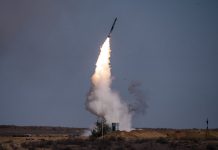A video of the US C-RAM air defense system shooting down rockets in Afghanistan earlier this year has gone viral on social media.
The video, which looks like a scene from the Star Wars movie, amused the viewers. While some of them seemed to be impressed, others took exception and played it down as was visible in the comments. However, it became the talk of the town soon after it was released.
Earlier this year, a sophisticated “US robot” shot down at least three missiles in Kabul. Five missiles were reportedly launched at the last American fighter planes, which were about to depart Afghanistan, according to media reports.
Witnesses in Kabul’s Khair Khana neighborhood later told the media that they heard “a few loud bangs” and saw some parked cars “taking fire” as a result of the blasts, reported the Telegraph in September this year.
?? C-RAM: One of America most powerful defense systems. pic.twitter.com/jn8eqSULVZ
— Kreately.in (@KreatelyMedia) November 30, 2021
The “US robot” later turned out to be the Counter-Rocket, Artillery, and Mortar (C-RAM) system.
“The C-RAM successfully took out one of the five missiles launched at the airport — as three others did not make it to the airfield,” Pentagon spokesman John Kirby said during a news briefing following the incident.
The C-RAM system, also known as the Phalanx by the US Navy, is a “system of systems” that has detected, alerted, and intercepted incoming rocket, artillery, and mortar rounds at forward operating bases and important targets in Iraq and Afghanistan, according to the US Army. It saved the US Air Force from what were the most horrific and exhausting days at Kabul for American forces.
The incident comes nine years after the US had first remarked that the Israeli Iron Dome defense system does not win wars but prevented them. This video of C-RAM defending an airport and US aircraft proves this right, said The Tribune.
The system can detect incoming enemy munitions as the C-RAM uses many layers of sensors, with a human operator verifying the target.
#BreakingNews A US military C-Ram intercepted a ISKP rocket barrage that targeted the Kabul Airport. The missile shrapnel rained down on the city but no casualties were reported. #Afghanistan pic.twitter.com/3ALsn4cZWl
— Conflict News (@ConflictCollec1) August 30, 2021
The US withdrew its troops from Afghanistan this year ending its two decades of war on terror, following which the Taliban took over the country. The leftover American forces as well as the Afghan military came under attack by non-state actors such as the ISIS-Khorasan towards the end of the takeover.
It was during this transition period when terrorists launched rocket attacks at the Kabul airport, prompting the US to use their C-RAMs.
These C-RAMs were among the various weapon systems that were disabled by the United States Military before they finally left Afghanistan.
What Is C-RAM?
C-RAM is an air-to-ground missile defense system that detects and destroys incoming rockets, artillery, and mortar rounds before they reach the ground. It uses a powerful machine gun that can fire up to 4,500 rounds per minute to take down close-range rockets, as well as missiles and artillery shells.
C-RAM was created by US weapon manufacturers to assist the US army in countering insurgent and militia missile, mortar, and drone attacks in Iraq and Afghanistan, both places where US had waged a war after its 9/11 attacks. It’s an adapted version of the Phalanx Close-In Weapon System used by the US Navy (CIWS).

The Federation of American Scientists’ Military Analysis Network (MAN) defines seven C-RAM functions: sense, alert, reply, intercept, command and control, shape, and protect.
C-RAM finished development, integration, and testing in April 2005 using this system-of-systems strategy.
It is housed on a trailer and can be launched from a distance. When a threat is identified, the weapon system identifies, evaluates, tracks, engages, and assesses battle damage automatically.
The American Centurion C-RAM uses the 20mm 2,000 RPM autocannon and it can protect a 1.2 sq km area from airborne attacks with a 60 to 70% shoot-down rate.
To avoid collateral damage on the ground, C-RAM employs additional tracking sensors, such as the Lightweight Counter Mortar Radar and Q-36 Target Acquisition Radar from the US Army. Multiple incoming shots can be targeted, tracked, prioritized, and eliminated before they hit the ground. They also provide a warning system for forces nearby.
According to the Commander of the US Joint Functional Component Command for Integrated Missile Defense Lt General Jim Dickinson, the US is working on a lot of electronic warfare and directed energy towards technology development.
He had previously stated that “a counter rocket, artillery, and mortar system will be fielded in the FY20 to 23 timeframe, with complete C-RAM capability by 2030”.
- Contact the author at sakshi.tiwari9555@gmail.com
- Follow EurAsian Times on Google News




